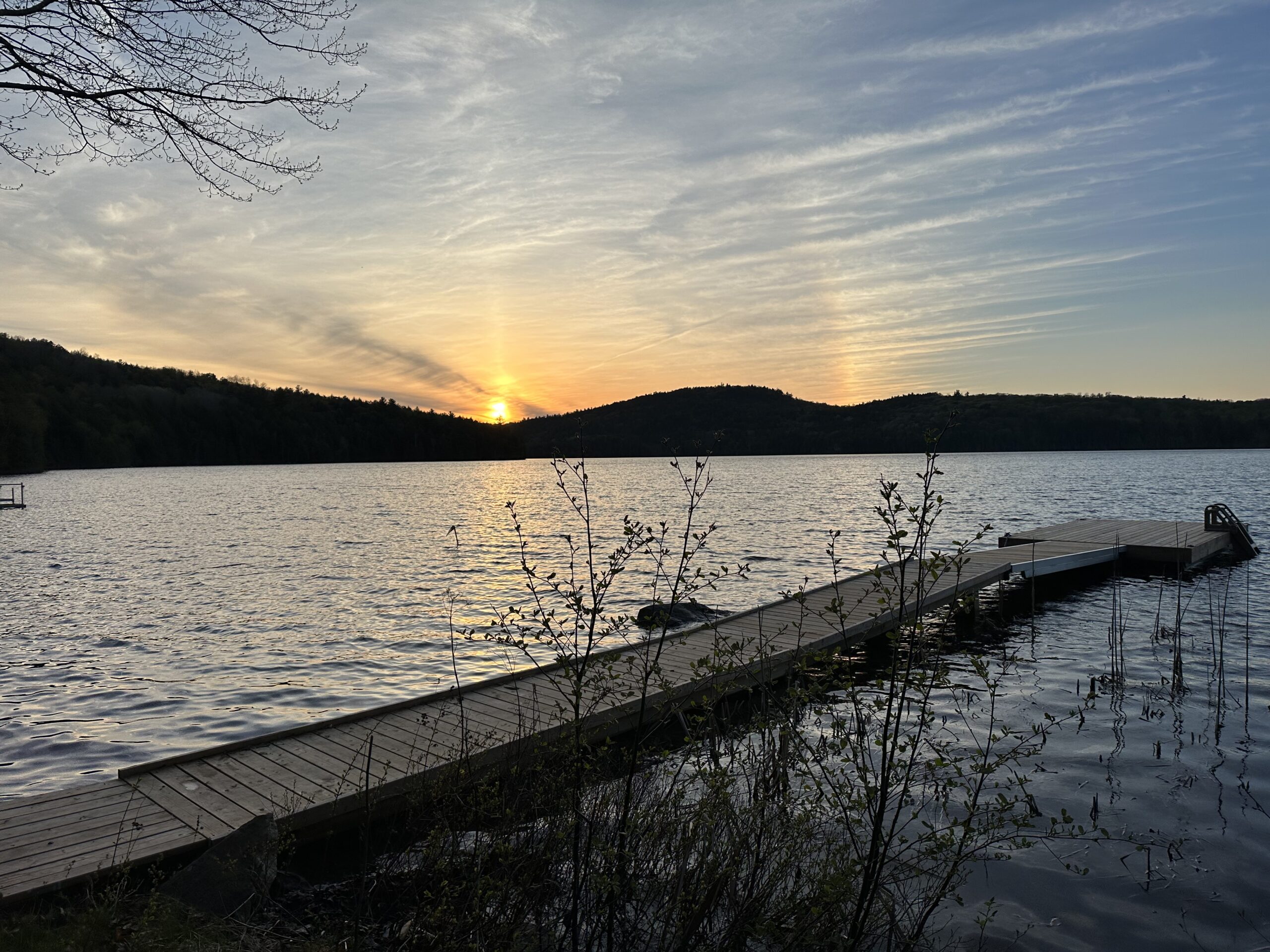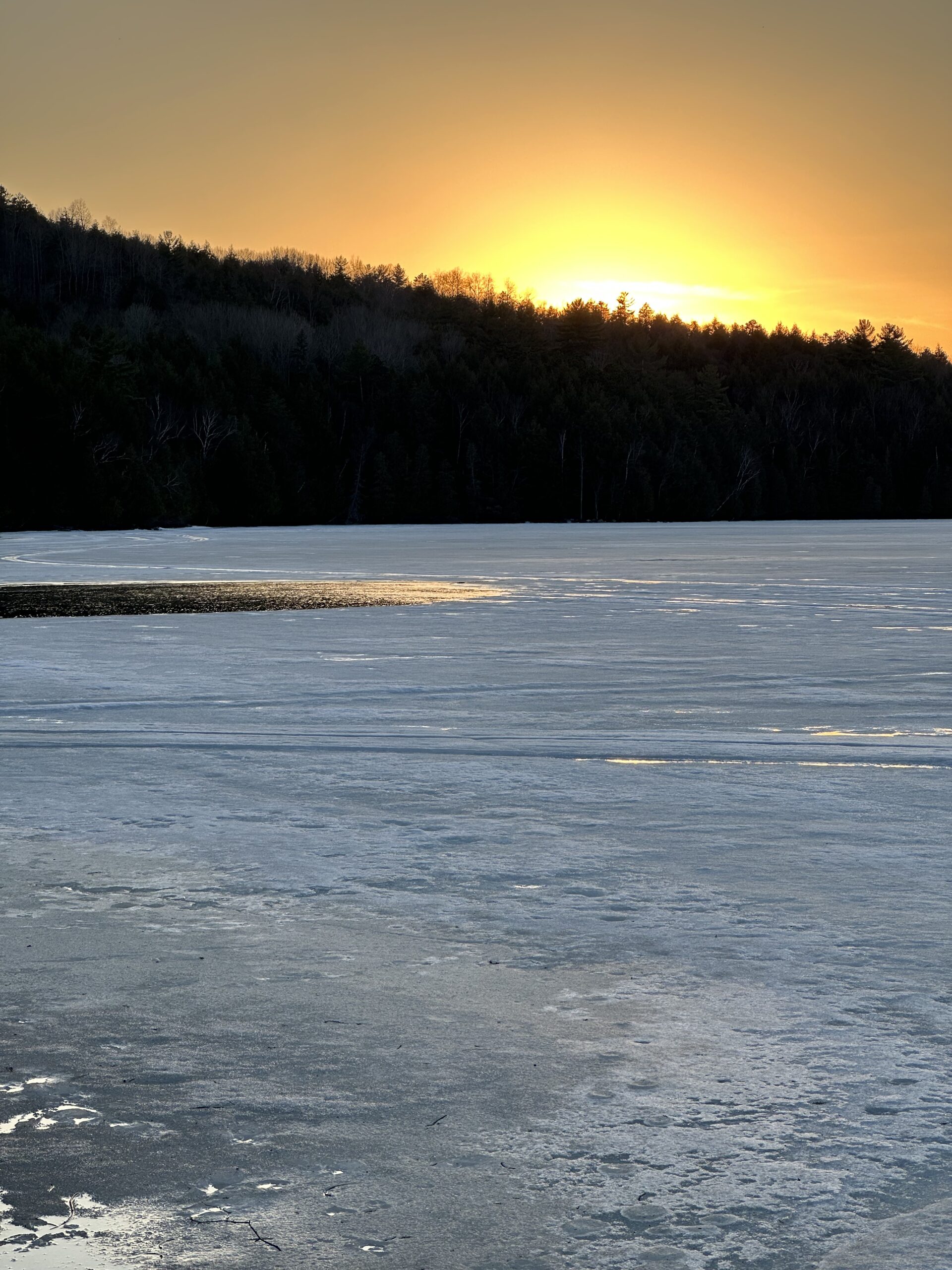We’ve only owned a cottage since Covid, and after replacing the original sinking dock with a brand spanking new one, we’ve had to figure out how to manage the moving parts. The first winter, we were dismayed to find a part of our dock frozen close to the shore—not where we left it. The dock comes in three pieces: the weighted ‘island’ floating dock, which is supposed to stay in place and freeze into the ice; the ramp (middle section), which gets removed for the winter; and the stationary platform permanently connected to shore.
Last spring, we simply arrived at the cottage and voila, the island was rescued and the ramp was magically set back up thanks to the help of a rescue crew who retrieved the wayward floating dock, and put the whole thing back together for us. A hired rescue crew. I naively thought the rescue was part of the initial package we paid for because of how casually the owner responded when I phoned to tell him what had happened. “No problem,” he said, “we’ll come fix that for you.” Whatever demented part of my brain believed that a company of men would drive an hour to rescue a dock, install it, and drive an hour back is now forever cured by the hundreds of dollars we paid, rightfully so, in labour. And so this year is the first time we are on our own for dock reinstallation.
The chasm between the floating dock island weighed down by 1,000 pounds that freezes into the ice through the winter and the stationary permanent platform seems woefully far, standing back at the shore. Dan and I scratch our heads. Our job is to install the ramp, which consists of a metal base with a massive 250-pound floating device that sits in place with the careful insertion of four sturdy pins. Once the metal ramp is in place, we have to lay down four sections of wooden planks on top to complete the installation. Which end to attach first? How to not crush one’s finger or fling oneself off the edge of the dock into the frigid rocky depths? How to avoid slamming hundreds of pounds of expensive equipment and damaging said equipment essential to cottage life? How to avoid going into the lake?
Well, as it turns out: brainstorming, trial and error, problem solving, meticulous planning and generosity of spirit.
One of us would have to go in the May water. That person would be Dan.
After debating dropping the 250-pound platoon attached to the metal frame of the ramp off the edge of the stationary platform, we rescinded. The idea seemed both foolish and dangerous. We would have no way to control the beast from smashing off the platform and huge boulder below. Instead, Dan’s idea, we ferried the ramp out from shore, and this worked quite well. Point, Dan and Adelle.
Dan has a better sense of how things work than I do, so I listened as he problem solved. Sometimes his lengthy pondering can rub up against my let’s just do it! attitude, but I see the benefit of carefully thinking things through here.
The wind seems to be picking up, and while we do ferry the heavy ramp out with success, our attempts to line up the unruly ramp to install the two metal pins on each side is another story. The oversized pins serve as the dock’s hinges. We go along with Dan’s proposed solution first. Attach the two pins closest to us, shore side, then attempt to manoeuvre the other two in. But the dock won’t quite move that way. No matter how much we pull and prod, we can only get three out of four mental pins in place.
The floating dock is immobilized by four 250-pound weights. Each of those weights is attached with heavy rope to an anchor accessible by unscrewing its respective wood panel. We hate messing with the ropes. That’s how we lost our floating dock the first summer, the ropes came untied in the waves and loosened all the way. This past winter, we added a heavy metal chain from floating dock to land for extra security.
Three out of four pins in place. What to do? What to do? The partially installed ramp is getting hammered with waves, the wind is matting my hair, the black flies making their presence known. We are now two hours into problem solving Dan’s way. We’ve tried installing the pins in from both sides first—same problem. “We have to loosen the ropes,” I say, “The water level’s raised; it’s got to be that.”
Dan isn’t quite sure, but it’s my turn to problem solve. He wades through the cold water, past his hips, with a drill in hand, and carefully removes the wood panel to access the rope to one of the weights. He loosens the rope all the way. There seems to be some give. He opens up another panel. Loosens the second rope. Now the dock is malleable and receptive to our manoeuvring, and Dan easily slides the posts into place to install the pins. Success!
“Hey! I was right!” I cannot resist gloating somewhat over having figured it out.
“You were. You were right, good job.”
From there, the four sections of boards fit on top, no problem. Dan didn’t even need me for that.
And while I wasn’t the one who went in the water, and I did not use the power tools, and I did not do the bulk of the lifting, and I definitely would not say I could have done the job on my own—it was my solution that achieved the desired result. Dan couldn’t have done it on his own, either. He would have figured it out eventually, but the job was done faster with two heads instead of one. So much of our life together is like this. One person taking the lead, and then the other stepping up to fill in the gaps. To make the dock whole.
Beers and cheers at the end of our finished dock? Definitely. We christened our work as the sun sank lower in the sky and kneeled down on the shadowed hillside.
Next up, time to fix the water line…



